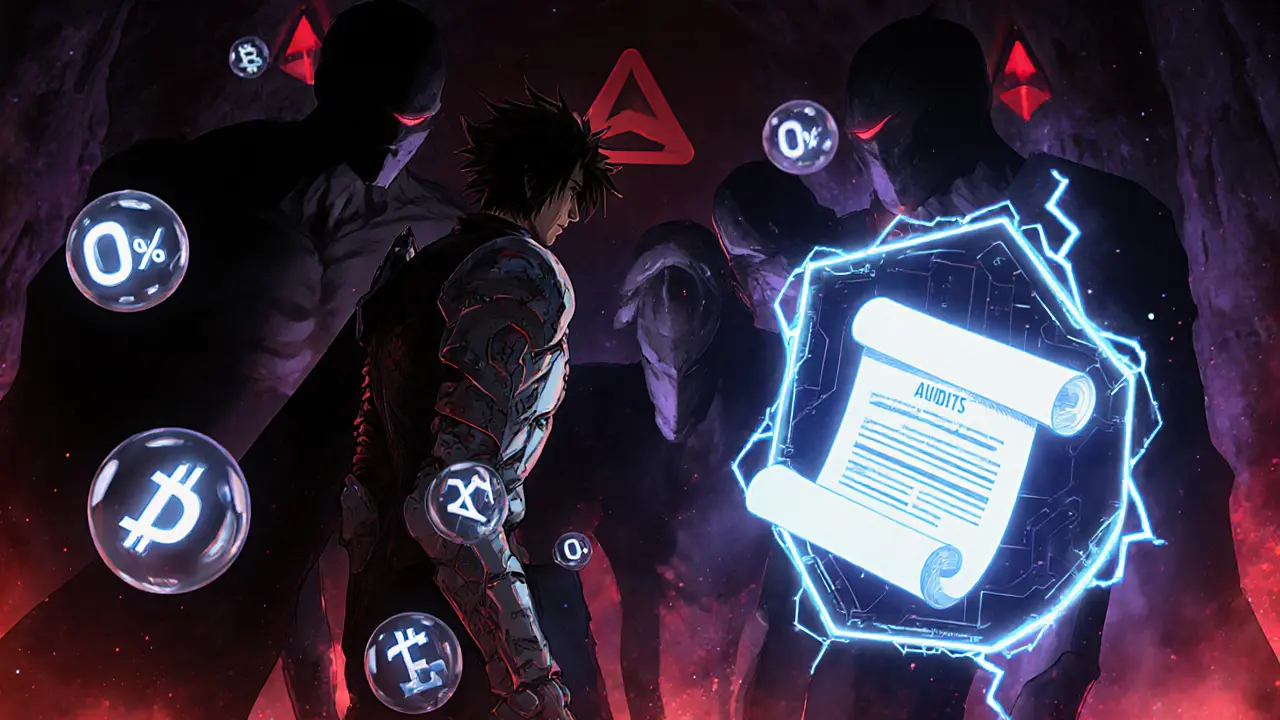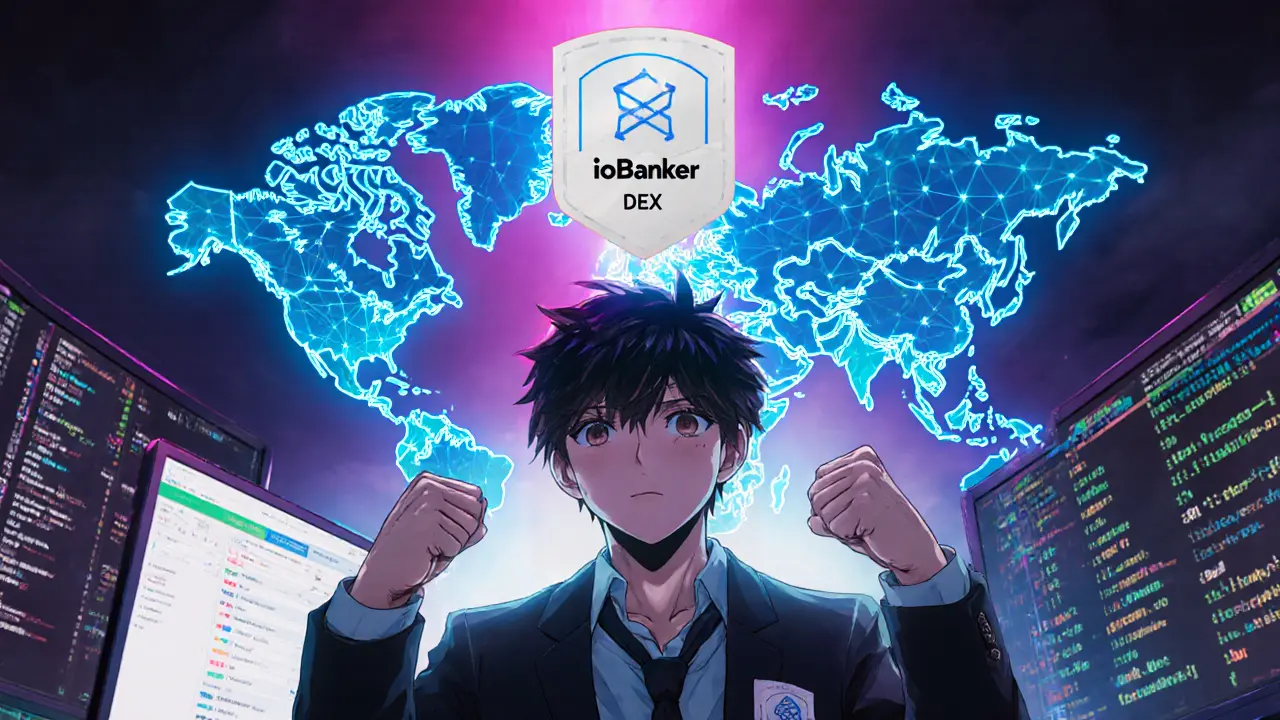ioBanker DEX Risk Assessment Calculator
Your Risk Assessment
Did you know that a tiny Estonian DEX launched in 2018 still runs on the same BitShares code while most of DeFi has jumped to newer blockchains? That’s the reality behind ioBanker, and anyone curious about its safety, costs, and usefulness needs a clear picture before risking real money.
Key Takeaways
- ioBanker DEX is a niche, BitShares‑based platform with limited public data.
- Supported assets are far fewer than on major centralized exchanges.
- Fees are comparable to other DEXs, but there’s no transparent fee schedule.
- Security and regulatory compliance details are scarce, demanding extra caution.
- Best for users already invested in the BitShares ecosystem or those experimenting with low‑volume, decentralized trades.
What is ioBanker DEX?
ioBanker DEX is a decentralized cryptocurrency exchange that launched on December 9, 2018, and operates from Estonia. It markets itself as a supporter of the new DeFi ecosystem built on BitShares technology, promoting what it calls “HONEST” protocols. Unlike centralized platforms, ioBanker never holds users’ funds; trades happen peer‑to‑peer through smart contracts on the BitShares blockchain.
How the Platform Works
The exchange runs on BitShares, a blockchain launched in 2014 that introduced delegated proof‑of‑stake and a built‑in decentralized exchange. BitShares enables fast, fee‑light settlement and native support for custom asset issuance. ioBanker leverages these features to let users trade BitShares‑based tokens without an order‑book middleman.
Its “HONEST” label refers to a set of open‑source protocols that aim to provide transparent governance and reduced front‑running risks. In practice, trades are matched via an automated market maker (AMM) model similar to Uniswap, but the liquidity pools are seeded primarily by BitShares community members.

Security and Regulatory Landscape
Security is the biggest unknown. Major exchanges such as Coinbase and Kraken publish annual proof‑of‑reserve audits, insurance policies, and bug‑bounty programs. ioBanker DEX, however, does not publicly disclose any security audits, penetration‑test reports, or insurance coverage.
The platform is based in Estonia, a country that historically offered crypto‑friendly licensing. Estonia requires cryptocurrency exchanges to obtain a virtual currency service provider license and comply with AML/KYC rules. There is no verifiable record that ioBanker holds such a license, making regulatory compliance unclear.
From a user‑risk perspective, the lack of transparent security measures means that funds are exposed to potential smart‑contract vulnerabilities, and there’s no recourse if something goes wrong.
Fees and Asset Support
Fee information is sparse. The exchange claims “low fees” typical of DEXs, but it does not publish a tiered schedule. Based on comparable BitShares DEXs, transaction fees hover around 0.1% of trade volume, with a small network fee for blockchain operations.
Asset variety is another weak point. While Coinbase lists over 200 cryptocurrencies and Kraken supports more than 350, ioBanker focuses almost exclusively on BitShares‑issued tokens and a handful of bridge assets. This limits its appeal for traders seeking broad market exposure.
| Feature | ioBanker DEX | Coinbase | Kraken | Binance US |
|---|---|---|---|---|
| Supported assets | ~20 BitShares‑based tokens | 235+ cryptocurrencies | 350+ cryptocurrencies | 158+ cryptocurrencies |
| Fee range | ~0.1% (network fee extra) | 0%‑3.99% (varies by volume) | 0%‑0.4% | 0%‑0.6% |
| Regulatory status | Unclear (no public license) | US‑registered, FDIC‑insured | US‑registered, extensive compliance | US‑registered, complies with FINRA |
| Security measures | Undisclosed smart‑contract audits | Cold storage, bug‑bounty, insurance | Cold storage, Kraken Security Labs, audits | Cold storage, SAFU insurance fund |
| Liquidity depth | Low‑medium, community‑driven pools | High, institutional investors | High, global market makers | High, Binance ecosystem |
User Experience and Community
Because ioBanker is a DEX, there is no traditional login or KYC portal. Users connect wallets directly via the BitShares wallet interface or third‑party extensions. This reduces friction but also means there’s no 24/7 customer support desk like the one Kraken offers across the US, UK, and Europe.
Community chatter is minimal. A quick search yields only a handful of forum mentions on BitShares‑related boards, and there are no official social media accounts with sizable followings. In contrast, platforms such as Uniswap, SushiSwap, and PancakeSwap each host active Discord and Telegram groups with thousands of members discussing pool incentives and new token listings.
For a newcomer, the learning curve can be steep: users must understand BitShares account permissions, resource management (CPU/NET), and how to add liquidity manually. The lack of tutorials or onboarding guides further hampers adoption.

Pros, Cons, and Who Might Benefit
- Pros
- True decentralization - no custodial risk.
- Low on‑chain fees thanks to BitShares’ DPoS model.
- Appeals to users already holding BitShares assets.
- Cons
- Very limited asset selection.
- No public security audits or insurance.
- Regulatory status ambiguous; possible compliance gaps.
- Thin liquidity can cause slippage on larger trades.
If you are a BitShares enthusiast experimenting with small amounts, ioBanker can serve as a sandbox for DeFi experiments. However, for regular traders seeking a broad portfolio, robust security guarantees, and reliable customer support, established exchanges like Coinbase, Kraken, or Binance US remain far safer choices.
Frequently Asked Questions
Is ioBanker DEX regulated in Estonia?
There is no publicly available record confirming that ioBanker holds an Estonian virtual currency service provider license. Prospective users should request proof of licensing directly from the platform before depositing significant funds.
How do I fund my ioBanker account?
Funding happens by sending supported tokens from a BitShares wallet to the smart contract address used by ioBanker. There is no custodial deposit; the assets remain in your wallet until you initiate a trade.
What security measures protect my funds?
Security relies on the underlying BitShares blockchain and the smart‑contract code that powers the exchange. Unlike centralized exchanges, ioBanker does not offer insurance, and it has not published independent smart‑contract audits, so users must trust the code or conduct their own review.
Can I trade non‑BitShares assets on ioBanker?
Currently the platform only lists tokens issued on the BitShares network and a few bridge assets that have been manually added. Major assets like Bitcoin, Ethereum, or Solana are not natively supported.
How does liquidity on ioBanker compare to Uniswap?
Uniswap benefits from deep liquidity pools across multiple Ethereum‑compatible tokens, often exceeding hundreds of millions in TVL. ioBanker’s pools are community‑driven and typically hold far less capital, leading to higher price impact for sizable trades.
Bottom Line
ioBanker DEX offers a genuine decentralized trading experience for a niche set of BitShares assets, but the scarcity of public security data, ambiguous regulatory standing, and limited token selection make it a high‑risk choice for most traders. Treat it as a curiosity or a sandbox for BitShares DeFi projects, and always keep the bulk of your portfolio on exchanges with proven compliance and robust security frameworks.











Comments (10)
Andrew Lin
October 8, 2025 AT 08:09 AMListen up, ioBanker is a total disaster if you value your hard‑earned cash. The so‑called "risk assessment" is a joke, and the fees are hidden in a maze of nonsense. They claim safety, but every crypto‑exchange has a backdoor, and they’re no different. If you think the DEX model protects you, you’re living in a fantasy world. I’ve seen similar platforms disappear overnight, taking users’ funds with them. Stop trusting fancy UI and do your own research before you get scammed.
Richard Bocchinfuso
October 15, 2025 AT 20:42 PMHonestly, putting money in a platform that hides fees is morally wrong. People get lured by low‑cost promises, only to lose everything later. It’s a shame you’re seeing these shady operations glorified. Think about the victims and the endless cycle of greed.
Melanie LeBlanc
October 23, 2025 AT 09:16 AMThe ioBanker review brings up a lot of points that deserve a nuanced look. First, the fee structure, while not the cheapest, is transparent compared to some other DEXs that obscure their costs with complex tokenomics. Second, the risk assessment calculator is actually a useful tool for beginners who might otherwise jump in blind; it forces users to consider volume, experience, and security priorities, which can mitigate impulsive mistakes. Third, the platform’s liquidity pools show decent depth for major pairs, offering relatively stable slippage for everyday traders. Fourth, the mobile app feels polished, with clear navigation and real‑time price alerts that can help active traders stay on top of market moves. Fifth, security features such as two‑factor authentication and cold‑storage options for larger balances are a plus, even if not industry‑leading. Sixth, the community support forums are active, and moderators often respond within a few hours, which can be reassuring for newcomers. Seventh, the integration of BitShares‑based assets opens up niche markets that other exchanges overlook, adding a layer of diversification. Eighth, the platform’s compliance with KYC/AML regulations may deter some privacy‑focused users, but it also reduces the risk of illicit activity, potentially making the exchange more stable. Ninth, the user interface, while clean, could benefit from more customizable dashboards for power users. Tenth, the fee discounts for high‑volume traders are modest, yet they reward loyalty. Eleventh, the educational resources, like webinars and tutorials, are fairly comprehensive, helping users build competence. Twelfth, the withdrawal limits are reasonable, preventing sudden large outflows that could destabilize liquidity. Thirteenth, the staking rewards are competitive, offering an additional income stream for passive investors. Fourteenth, the platform’s roadmap includes upcoming features like cross‑chain swaps, which could broaden its appeal. Fifteenth, overall, ioBanker seems to strike a balance between accessibility for newcomers and tools for seasoned traders, making it a viable option for many.
Don Price
October 30, 2025 AT 20:49 PMLook, the whole "risk assessment" is a smokescreen. If you really trust a calculator, you’re ignoring the fact that every crypto exchange is vulnerable to insider manipulation, backdoor exploits, and coordinated attacks. The only thing that keeps you safe is staying off the platform entirely. Governments are already monitoring these DEXs, and the next regulation will probably shut them down. Don't be fooled by the slick UI; it's a trap.
Jasmine Kate
November 7, 2025 AT 09:22 AMWhoa, drama alert! The fees on ioBanker are like hidden landmines. You think you’re paying a little, then BOOM, surprise charge on a tiny trade. It’s a classic case of “look before you leap,” except they hide the leaper’s foot. If I were the CEO, I’d be ashamed. People deserve better transparency, not this shady circus.
Mark Fewster
November 14, 2025 AT 21:56 PMActually, the fee breakdown is posted on their website, and if you scroll down, you can see the exact percentages for maker and taker fees. It’s just a matter of taking a moment to read the fine print. Many users overlook this, but the information isn’t hidden; it’s just not front‑and‑center.
Dawn van der Helm
November 22, 2025 AT 10:29 AM✨ Loving the vibe of ioBanker! The interface feels fresh, and the community is super supportive. 😎 If you’re just starting out, the risk calculator can be a nice confidence boost. Keep an eye on the fees, but overall it’s a solid place to dip your toes into crypto. 🌊🚀
Monafo Janssen
November 29, 2025 AT 23:02 PMThanks! I’ve found the calculator especially helpful because it forces you to reflect on your own risk tolerance. It’s a simple tool, but for beginners it’s a good reminder to stay within limits and maybe avoid over‑leveraging. The platform also offers helpful tutorials that explain each step.
Michael Phillips
December 7, 2025 AT 11:36 AMFrom a philosophical standpoint, exchanges like ioBanker embody the tension between decentralization and central oversight. While they promise autonomy, the underlying code and governance still reflect human biases. Users should contemplate the ethical dimensions of entrusting value to algorithmic systems that may be prone to manipulation. In the end, the decision to engage should align with one’s personal values about control and trust.
Jason Duke
December 15, 2025 AT 00:09 AMRight, but let’s get practical: the fees are about 0.2% maker and 0.3% taker, which is in line with most mid‑size DEXs. If you’re trading high volume, the discount tiers bring it down a bit more. So, it’s not a deal‑breaker, just something to factor into your profit calculations.